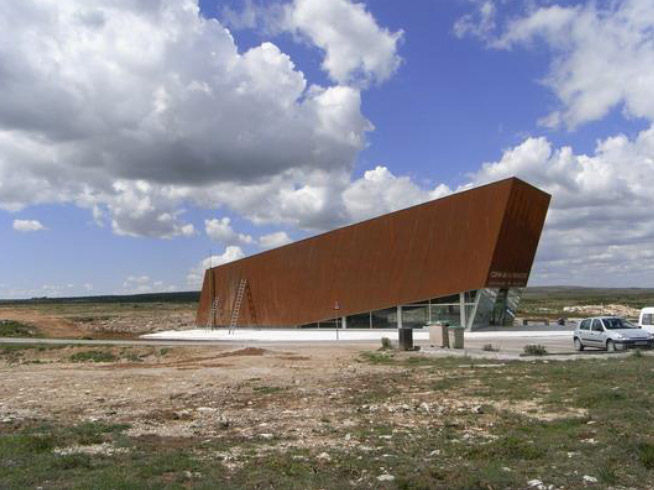
Meeting point 0. The Entrance to the Cave

Welcome to Lora of Valdivia. From this point on, we’ll be on an audio-guided tour through a number of selected sites in order to better know this protected natural area of Covalagua. As we walk through with the audioguide, we will have a detailed look at the Frenchmen Cave, the standing stone of Cantohito, the Wolves Well, the Valcabado viewpoint, and several other ítems of interest.
Lora of Valdivia, due to its vast extension eastwards, shares its territory with the Burgos and Palencia provinces, known as the Lora Moorland. It is part of a unique landscape which also includes the Lora of the Tuerces, Peña Mesa, the Ulaña and Peña Amaya. All these Loras stand out in the landscape like real castles, and in many cases throughout history, they have been used as fortresses and natural shelters by their inhabitants.
If you have time, we suggest you visit them with the audioguide. They all contain true geological, biological and cultural treasures. The building where we are standing is used as the entrance to the Frenchmen Cave, and was inaugurated in 2009 by the Provincial Council of Palenthia. It has a number of interactive elements and models that help the visitor understand how caves are formed and what is inside them. During the tour, you will be able to know in detail how water has been sculpting and giving shape to all the amazing forms that appear inside.
Occasionally, the water, in addition to running inside the caves, flows outwards, as it happens in the Covalagua upwelling, giving rise to the Ivia river. To visit this beautiful natural waterfall, leave your car at the parking area located before you arrive at the Frenchmen Cave, then walk the 500 meter marked path.
Once there, you will be able to see how water has been moulding the cascade’s steps. This happens not by rock erosion, but by the calcium carbonate being dissolved in wáter, which precipitates on leaves, branches and moss found on its path, forming what are known as tuffaceous rocks. The next meeting point is located in the cave’s back, at the start of the Cantohito route.
Meeting point 1. Joints
The Lora of Valdivia area in Palenthia province is between 1,170-1,200 meters in height. On this journey towards Cantohito, about 1,000 meters away, a number of meeting points such as this one will be discovered, which will give you information about some of the most important features from this territory, in addition to the information this audioguide will provide you.
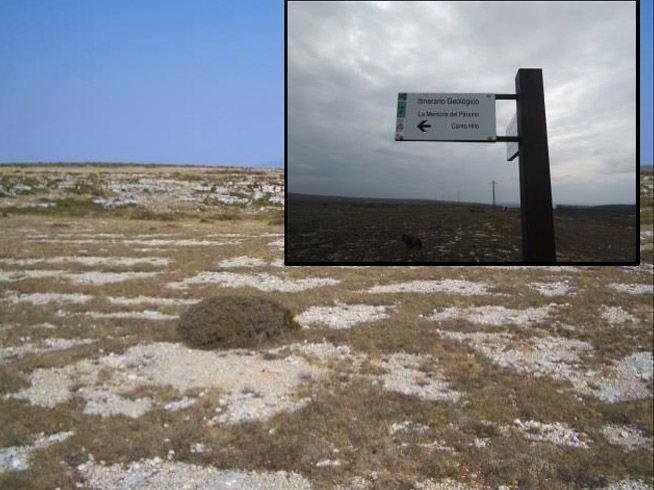
To begin with, if you look closely at the ground, many spots from this Lora give the impression that the ground is made up of large rectangular limestone tiles separated from each other by thin lines of vegetation. These lines are really just limestone fractures, which are very important in the development of caves. Rainwater passes inward through these cracks, which results in the dissolution and precipitation processes of calcium carbonate. These fractures are named joints.
If you have the opportunity to see an aerial photograph (like the one on the Revilla of Pomar rest area’s canopies) you can perfectly distinguish this network of joints, as well as sinkholes and limestome pavements which will be seen later with the audioguide. The next meeting point can be seen from here, a few meters to our left, the Pit Cave, surrounded by a stone wall with a circular shape.
Meeting point 2. Pit cave
This natural crack in the earth was also the result from water erosion. It is 8 meters Deep and reaches the interior of the cave. During the War of Independence in 1808, Napoleonic troops fought against Cantabrian Hussars, who were a light cavalry unit led by Brigadier Por-lee-AY. It was a bloody battle which resulted in the victory of the Spanish troops. Since there were difficulties in burying all of the dead fighters, the French soldiers were thrown into the Pit Cave, where 70 corpses were later discovered.
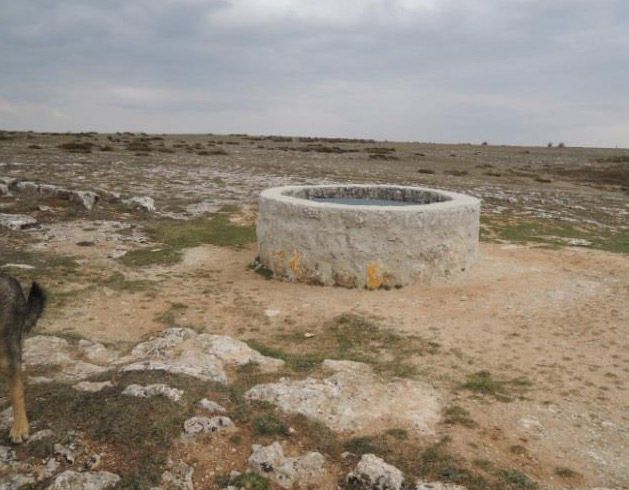
Since 1898, documents have been discovered which show evidence of the Cave and its surroundings. However, it was in 1904 when Don Luciano Huidobro Serna, parish priest of Villadiego, took matters into his own hands and had the authorities make it public. This cave and others were also used during the Civil War. During that period, the caves were refuges for the Republican Guerrillas from Palenthia, among them "The Lobster" gang from the Bal-DEE-bia area. The next meeting point can be found on the first stone pile built as a milestone to indicate the path towards Cantohito.
Meeting point 3. Geology
The first thing to know is that the walk that we going to take with the audioguide used to be at the bottom of the ocean 90 million years ago. The limestone that can be seen today were the sediments settled during the Late Cretaceous Period.
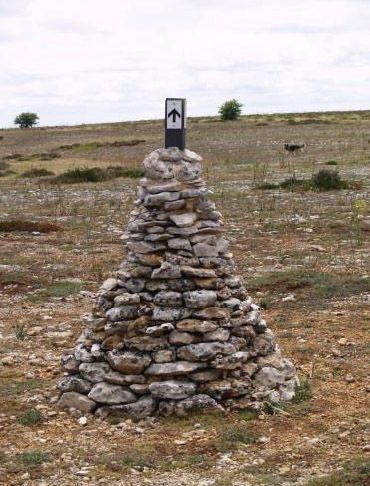
Numerous fossils can be found in the area, which give us valuable information about this geological period. It is common to find rudists and corals forming real reefs. The presence of these fossilized organisms indicates that 90 million years ago this area was occupied by a shallow sea with warm water temperatures, typical of tropical areas.
All of these marine sediments were folded and fractured 30 million years ago, due to earth’s tremendous internal forces, eventually emerging from the ocean to form part of the Iberian Peninsula in a geological event called "Alpine Orogeny". The next meeting point can be found at the stone pile ahead.
Meeting point 4. Sinkhole
Limestones are formed by calcium carbonate. This compound can be dissolved relatively easily in wáter, which contains carbon dioxide, CO2. This limestone’s feature creates a very special landscape known as karst. The dissolution processes inside the subsoil form caves with stalactites and stalagmites, underground passages, and so on. Also, on the outside, one can find many morphologies typical from this landscape.
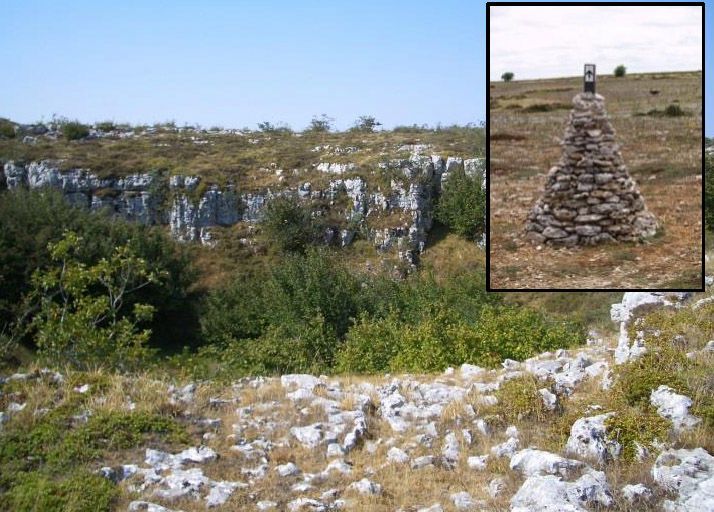
One of the most significant structures is that of sinkholes, in this area known as pits or ogas. On our way to Catohito with the audioguide, we will cross or go around some of them. Sinkholes are small geological depressions, roughly circular in shape, which are formed by the dissolution of soil’s limestone. In the early stages of its formation, puddles are formed by rainwater. The accumulated water seeps through cracks into the subsoil, dissolving the calcium carbonate from the limestone. This leaves clay minerals at the bottom that are not soluble in water. Numerous sinkholes can be found in all Lora of Valdivia. Some of them have been used to grow crops, because of the clay soil, which is very fertile.
Occasionally, a sinkhole is formed by the collapse of a space in the earth, forming a funnel-shaped pit. Toward the south of Lora of Valdivia, close to Cantohito, you will see large sinkholes, with hazel nut, gall oak or Pyrenean oak trees that grow in the shelter of these spectacular depressions. The next meeting point can be found with the audioguide on the stone pile ahead.
Meeting point 5. Flora
Loras’s climatic conditions are quite harsh. Temperatures throughout the year are highly variable and extreme. Strong winds blow intensely through these moorlands. In addition, rainwater quickly seeps through cracks or joints resulting in low humidity. The presence of limestone results in poor soil. For these reasons, there are only a few plant species that are able to adapt and live here. They are the rupicolous plants which grow between crevices in the rock. Among them are the rabbit ear plant, the tea rock plant or the bellflower.
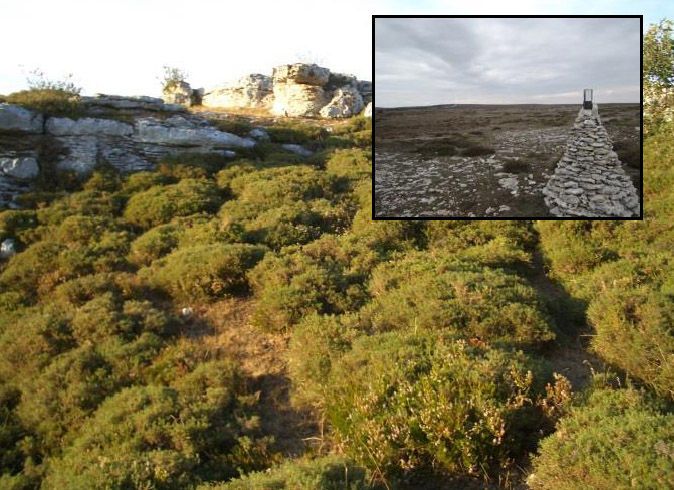
When there is a bit of soil in the area, which happens with the beginning stages of the sinkhole that we have walked through with the audioguide, you will find heathers, gorses and bearberries, field penny-cresses, red valerians and some rare orchids which are listed as protected species. All of these plants can only be seen blooming in mid spring.
In the more developed sinkholes, sheltered from these depressions, climatic conditions are somewhat better for the growth of shrub species, such as hazel, common hawthorn, junipers or terebinth. On the walls, you’ll find a number of ferns such as Rustyback or maidenhair, as well as Venus’s navel.
Meeting point 6. Wildlife
Let's talk now in this section of the audioguide about the diverse wildlife that inhabits the Loras in general, and Valdivia in particular. The geological characteristics and the evolution that has taken place in the landscape have led to a series of very abrupt walls which can be seen at the footsteps of Valcabado Viewpoint. This is nesting ground for a number of birds of prey, such as the griffon vulture, the common kestrel, the Egyptian vulture, Eurasian eagle-owl and peregrine falcon. There are also corvids, such as red-billed chuff, rooks and the fast Eurasian crag martin. In the moorland in spring, one is able to hear the song of the Eurasian skylark, the woodlark and the northern wheatear, and, if you are lucky, you will see some Montagu's harrier searching for food.
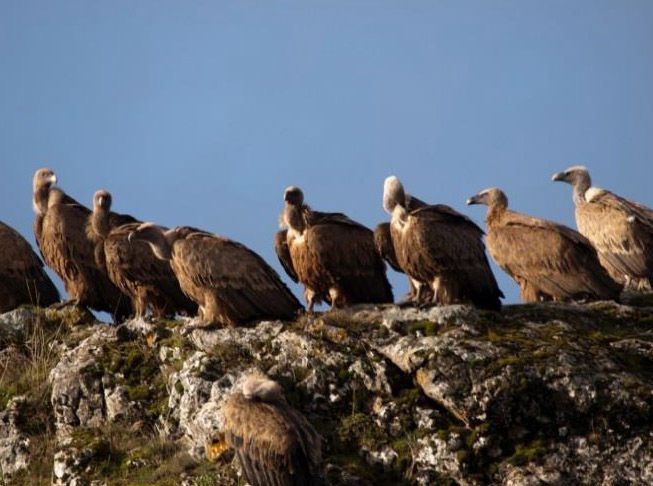
But not only birds can be seen during the tour with the audioguide. Mammals, such as foxes and beech martens shelter among these rocks. Roe deer are common inhabitants in the Lora área, and, more elusive, the wolf crosses this territory.
Invertebrates are also hidden among the stones. Numerous species of spiders and insects find Lora a good place to live. Of special interest are the reptiles in these areas. There are skinks, green and ocellated lizards and snakes, such as the southern smooth and the viperine (“viper-in”). Be especially careful when lifting any of these rocks, since snakes take shelter under them. All of this wildlife has adapted to Lora’s harsh conditions. The next meeting point can be found on the direction post that is just before arriving at Cantohito.
Meeting point 7. Cantohito
This limestone standing stone you can now see with the audioguide is 3.25 meters tall and tilts towards the east. It is one of the many megaliths that can be found in Lora of Valdivia. Along with other similar stones found in Burgos, northern Palenthia and Cantabria, they make up an excellent set. These standing stones, or “menhirs,” form a southeast to northwest alignment. There are several interpretations concerning this particular orientation. It is believed that they could be markings on the ground that point out routes. They could be boundary lines, or become meeting points. The stones could also mark the way of a funeral avenue, or have a symbolic or ritual significance since some of them show markings on their surface. It is important to put these standing stones into context, that of 6,000 years ago, with agropastoral communities that lived and moved throughout these territories in search of pasture. It is difficult to choose from one of these theories without more data. Ongoing research brings new findings to light, including dating and reconstructions. The stone circle surrounding the menhir seems to be of a much later date.
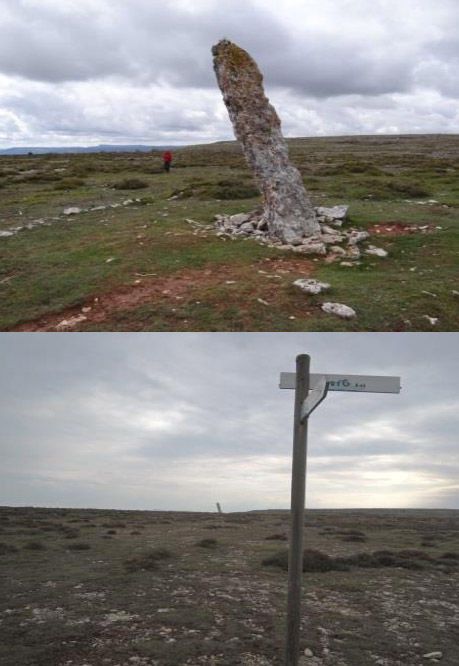
Along the tour with the audioguide, something that may have caught your attention is a series of small walls that appear scattered throughout the Lora area. These are, in fact, windbreaks that shepherds, in more recent periods, built for small shelters while the cattle grazed around freely. The locals call them “casitos”. If you go through Cantohito and move forward a few meters in the same direction, two well-developed sinkholes can be seen on each side.
Meeting point 8. The limestone pavements
Going through Loras means walking on red soil, as you can see with the audioguide. This was formed by the alteration of limestone, cushioned by the vegetation that covers the surface, and sometimes cracked rocky soil with strange shapes. The latter are areas where it is difficult to walk, wearing the soles of one’s shoes as well as animals’ pads. In geology, they are called limestone pavements--the result of limestone dissolution by water. Because of this process, grooves are formed, some deeper than others, as well as rock-sharp ridges. Water enters the limestone massif, dissolving its interior, giving shape to caves, galleries and pit caves.
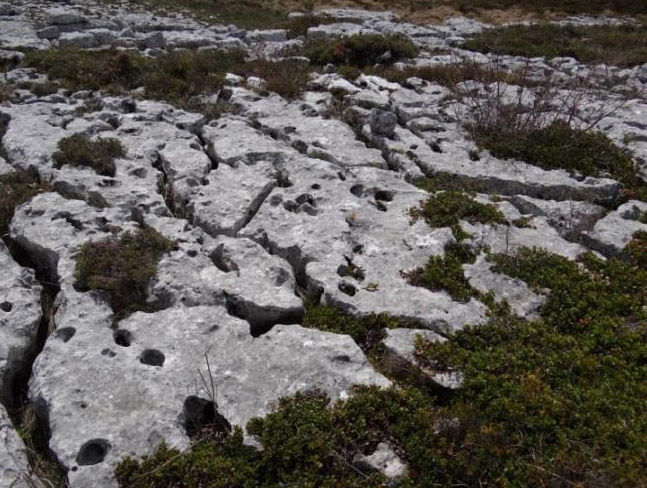
Throughout the years, the grooves, joints and cavities are widened by water erosion, causing landslides, subsidence and fancy shapes. An "enchanted city" which can be seen at Tuerces natural area, a few kilometers from here, is what in geology is called badlands.
Meeting point 9. Valcabado viewpoint
This viewpoint is a spectacular balcony over the Valderredible valley. Most of what you see with the audioguide is in the Cantabrian territory. There are also towns which belong to Palenthia province, such us Berzosilla, Lastrilla and Cezura. In the interpretive panel, you can see the names of the different population centers in detail, as well as their exact location. At our feet, Ahedo Mounting, a thick beech forest for pleasant walks. Further to the left, there is a magnificent view across the Palenthia Mountains, with its highest peaks Valdecebollas, the Espigüete and Curavacas. To the Valderredible Valley’s right, you can see the Lora of Valdivia from Burgos province, which is called the Moorland of the Lora, or the Cid’s leg, sprinkled by wind turbines that stand like giants.
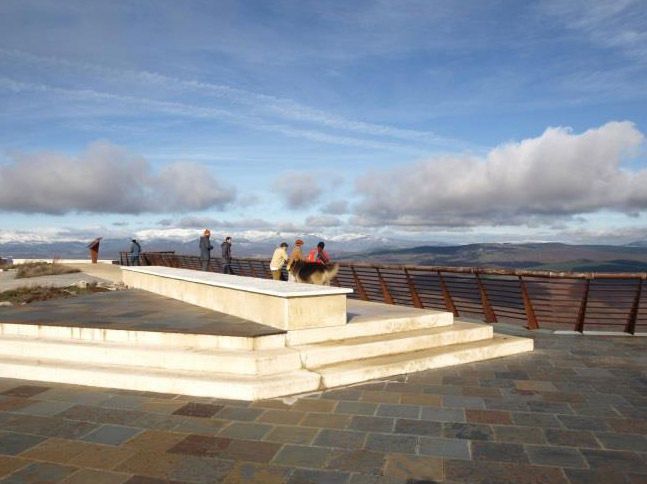
But there is not only the magnificent view from this direction. If you turn around with the audioguide, you can see the vast Lora of Valdivia. From here, one can clearly see the wild and evocative landscape so characteristic of these limestone moorlands. In the background, Peña Amaya and Ulaña, two of the most representative Lora of this countryside. The next meeting point is at the directional post, close to the Wolves Well.
Meeting point 10. Wolves Well
Wolves Well: that is how this rebuilt structure from an old wolf trap is known. For centuries, it was used to capture and kill wolves. This structure consisted of an alley with high walls made out of stones or sticks several hundred meters long, narrowing like a funnel. The shepherds chased after the wolves in order to guide them into the circular well. This was surrounded by a palisade which didn’t allow the animal to escape once inside. Then the wolf were killed by the shephers throwing stones at them from the top.
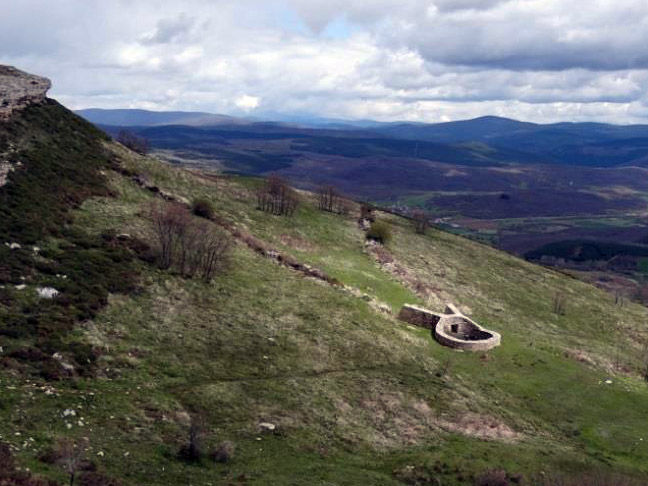
Traps of this kind or similar have been built in regions where the economy was based on livestock and the wolf was a threat. Today, the presence of wolves in this area is scarce, although occasionally they can be seen running through these moorlands with the audioguide.
The Frenchmen Cave: Revilla de Pomar - 34813 (Palencia, España)
- Tel.: +34 659 94 99 98 - cuevadelosfranceses@diputaciondepalencia.es - www.lacuevadelosfranceses.es
Back to Index